Construction Technology Report: Building Design and Services
VerifiedAdded on 2023/01/04
|14
|4044
|25
Report
AI Summary
This report on construction technology delves into various aspects of building construction, beginning with an introduction to the field and its application in a sustainable hotel project. The main body of the report explores the differences between residential, commercial, and industrial buildings, examining their functional characteristics and design selection criteria. It further discusses strategies for promoting sustainability in building projects, including waste management, site management, and resource management. The report also defines key terminology used in construction technology and analyzes pre-design studies, types of information collected, and the elements of building substructure and superstructure. Techniques for site remediation and the types of substructure works carried out by civil engineers are also examined. Finally, the report addresses supply and distribution arrangements for primary services in the context of a case study, providing a comprehensive overview of construction technology principles and practices.
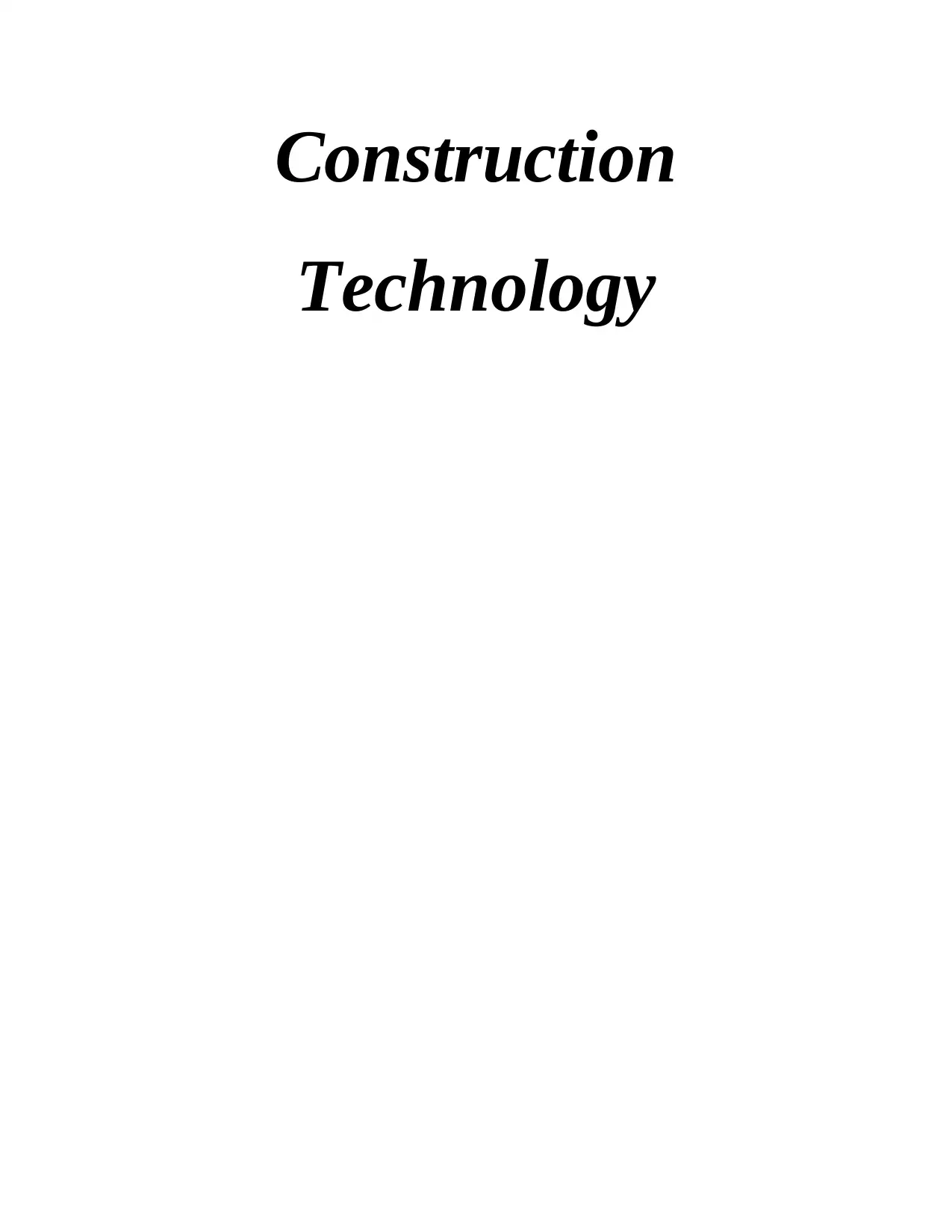
Construction
Technology
Technology
Secure Best Marks with AI Grader
Need help grading? Try our AI Grader for instant feedback on your assignments.
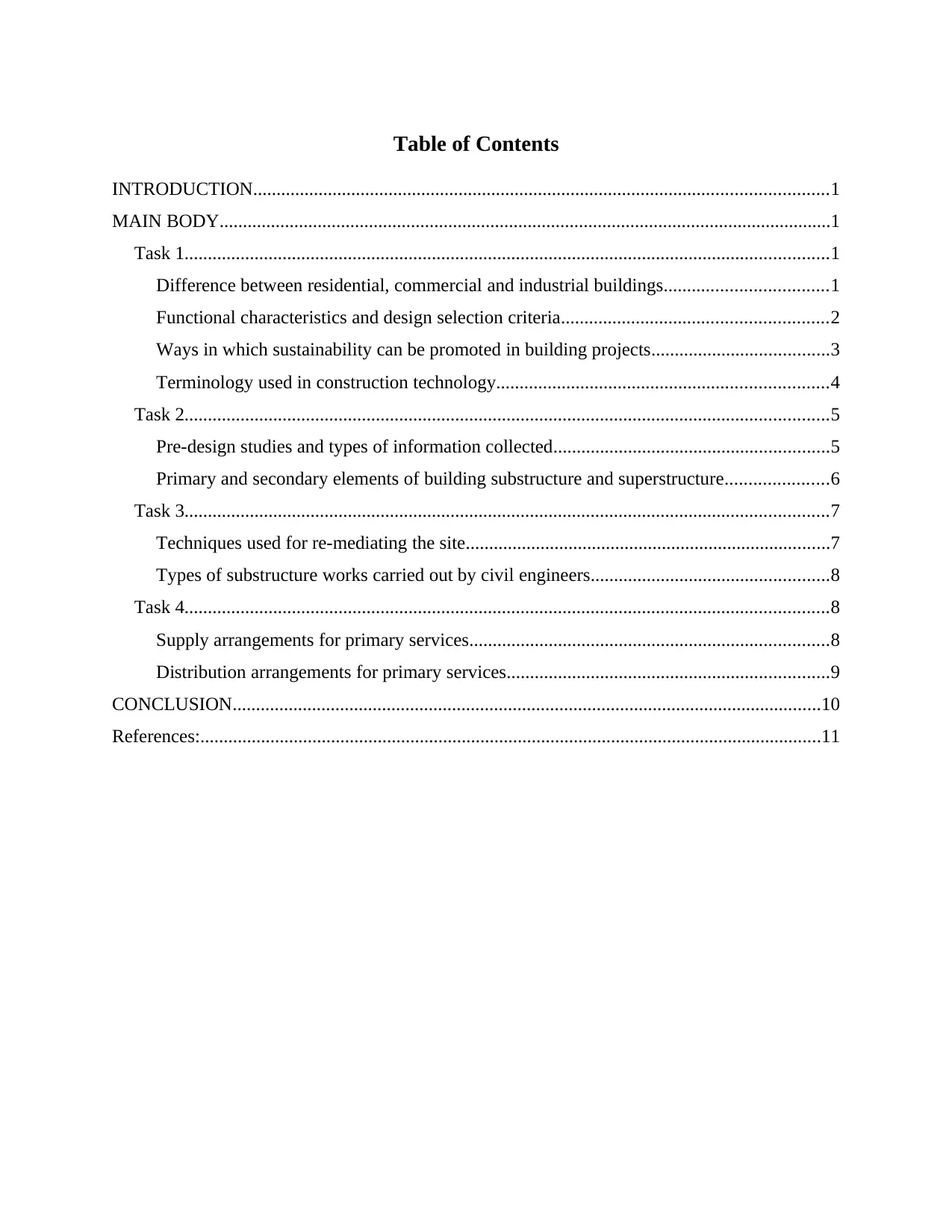
Table of Contents
INTRODUCTION...........................................................................................................................1
MAIN BODY...................................................................................................................................1
Task 1..........................................................................................................................................1
Difference between residential, commercial and industrial buildings...................................1
Functional characteristics and design selection criteria.........................................................2
Ways in which sustainability can be promoted in building projects......................................3
Terminology used in construction technology.......................................................................4
Task 2..........................................................................................................................................5
Pre-design studies and types of information collected...........................................................5
Primary and secondary elements of building substructure and superstructure......................6
Task 3..........................................................................................................................................7
Techniques used for re-mediating the site..............................................................................7
Types of substructure works carried out by civil engineers...................................................8
Task 4..........................................................................................................................................8
Supply arrangements for primary services.............................................................................8
Distribution arrangements for primary services.....................................................................9
CONCLUSION..............................................................................................................................10
References:.....................................................................................................................................11
INTRODUCTION...........................................................................................................................1
MAIN BODY...................................................................................................................................1
Task 1..........................................................................................................................................1
Difference between residential, commercial and industrial buildings...................................1
Functional characteristics and design selection criteria.........................................................2
Ways in which sustainability can be promoted in building projects......................................3
Terminology used in construction technology.......................................................................4
Task 2..........................................................................................................................................5
Pre-design studies and types of information collected...........................................................5
Primary and secondary elements of building substructure and superstructure......................6
Task 3..........................................................................................................................................7
Techniques used for re-mediating the site..............................................................................7
Types of substructure works carried out by civil engineers...................................................8
Task 4..........................................................................................................................................8
Supply arrangements for primary services.............................................................................8
Distribution arrangements for primary services.....................................................................9
CONCLUSION..............................................................................................................................10
References:.....................................................................................................................................11

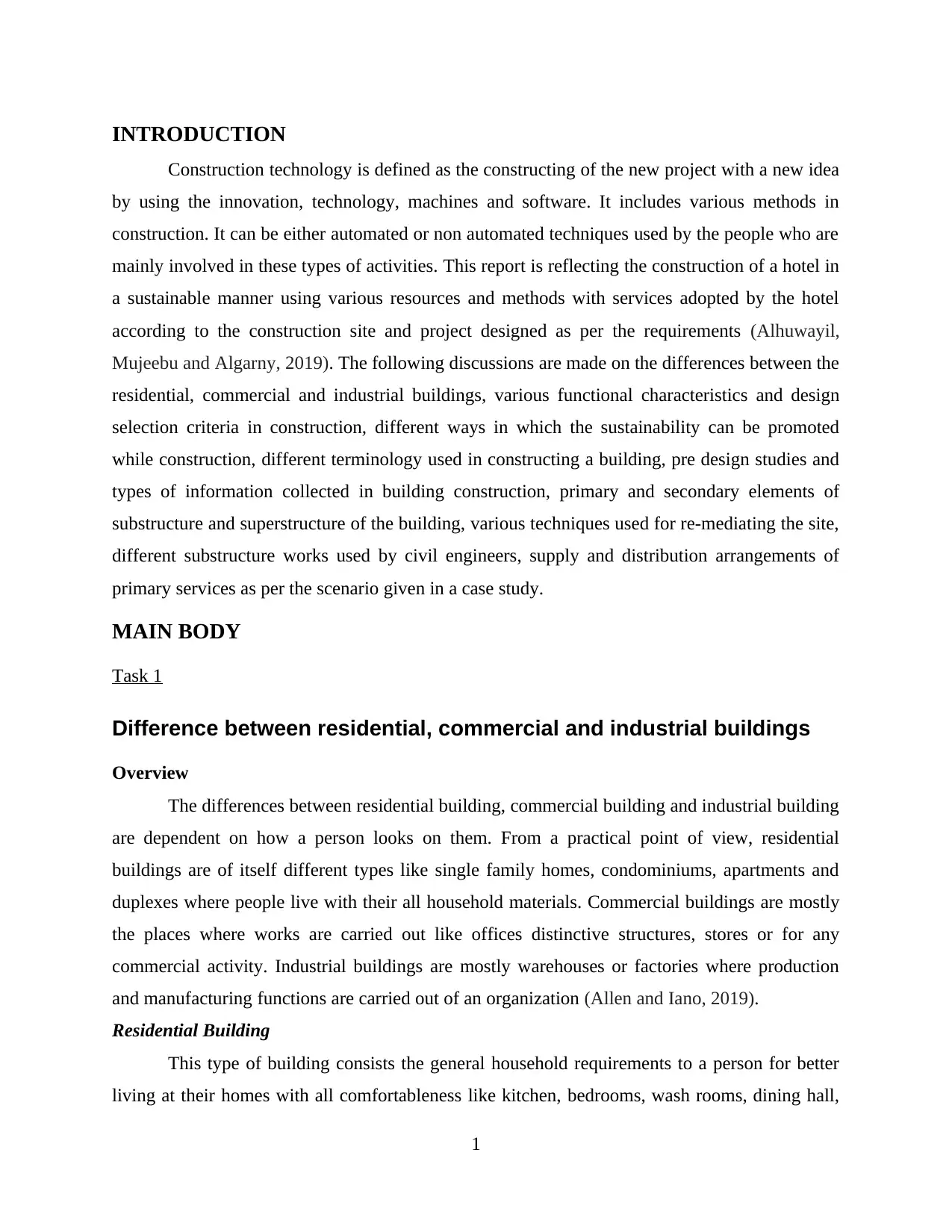
INTRODUCTION
Construction technology is defined as the constructing of the new project with a new idea
by using the innovation, technology, machines and software. It includes various methods in
construction. It can be either automated or non automated techniques used by the people who are
mainly involved in these types of activities. This report is reflecting the construction of a hotel in
a sustainable manner using various resources and methods with services adopted by the hotel
according to the construction site and project designed as per the requirements (Alhuwayil,
Mujeebu and Algarny, 2019). The following discussions are made on the differences between the
residential, commercial and industrial buildings, various functional characteristics and design
selection criteria in construction, different ways in which the sustainability can be promoted
while construction, different terminology used in constructing a building, pre design studies and
types of information collected in building construction, primary and secondary elements of
substructure and superstructure of the building, various techniques used for re-mediating the site,
different substructure works used by civil engineers, supply and distribution arrangements of
primary services as per the scenario given in a case study.
MAIN BODY
Task 1
Difference between residential, commercial and industrial buildings
Overview
The differences between residential building, commercial building and industrial building
are dependent on how a person looks on them. From a practical point of view, residential
buildings are of itself different types like single family homes, condominiums, apartments and
duplexes where people live with their all household materials. Commercial buildings are mostly
the places where works are carried out like offices distinctive structures, stores or for any
commercial activity. Industrial buildings are mostly warehouses or factories where production
and manufacturing functions are carried out of an organization (Allen and Iano, 2019).
Residential Building
This type of building consists the general household requirements to a person for better
living at their homes with all comfortableness like kitchen, bedrooms, wash rooms, dining hall,
1
Construction technology is defined as the constructing of the new project with a new idea
by using the innovation, technology, machines and software. It includes various methods in
construction. It can be either automated or non automated techniques used by the people who are
mainly involved in these types of activities. This report is reflecting the construction of a hotel in
a sustainable manner using various resources and methods with services adopted by the hotel
according to the construction site and project designed as per the requirements (Alhuwayil,
Mujeebu and Algarny, 2019). The following discussions are made on the differences between the
residential, commercial and industrial buildings, various functional characteristics and design
selection criteria in construction, different ways in which the sustainability can be promoted
while construction, different terminology used in constructing a building, pre design studies and
types of information collected in building construction, primary and secondary elements of
substructure and superstructure of the building, various techniques used for re-mediating the site,
different substructure works used by civil engineers, supply and distribution arrangements of
primary services as per the scenario given in a case study.
MAIN BODY
Task 1
Difference between residential, commercial and industrial buildings
Overview
The differences between residential building, commercial building and industrial building
are dependent on how a person looks on them. From a practical point of view, residential
buildings are of itself different types like single family homes, condominiums, apartments and
duplexes where people live with their all household materials. Commercial buildings are mostly
the places where works are carried out like offices distinctive structures, stores or for any
commercial activity. Industrial buildings are mostly warehouses or factories where production
and manufacturing functions are carried out of an organization (Allen and Iano, 2019).
Residential Building
This type of building consists the general household requirements to a person for better
living at their homes with all comfortableness like kitchen, bedrooms, wash rooms, dining hall,
1
Secure Best Marks with AI Grader
Need help grading? Try our AI Grader for instant feedback on your assignments.
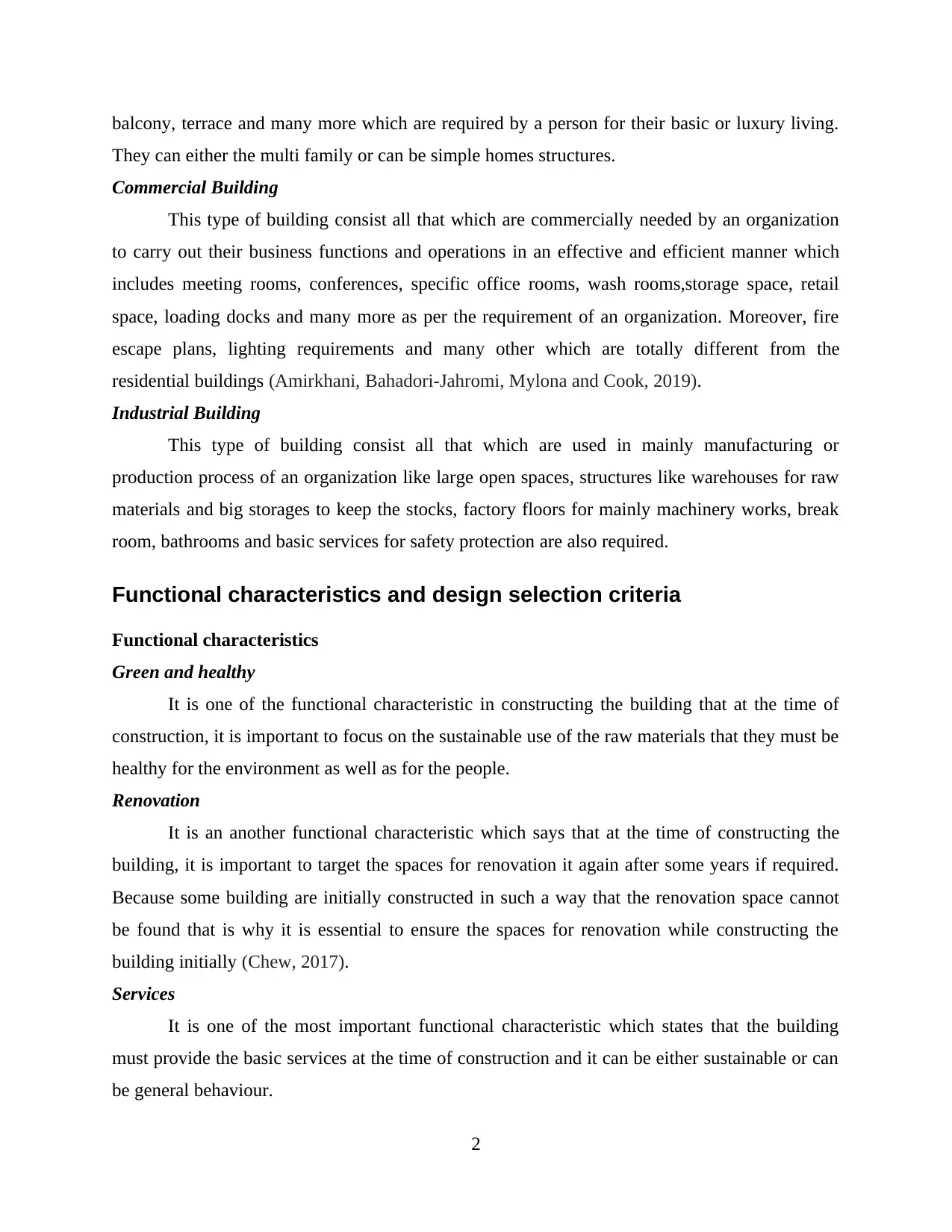
balcony, terrace and many more which are required by a person for their basic or luxury living.
They can either the multi family or can be simple homes structures.
Commercial Building
This type of building consist all that which are commercially needed by an organization
to carry out their business functions and operations in an effective and efficient manner which
includes meeting rooms, conferences, specific office rooms, wash rooms,storage space, retail
space, loading docks and many more as per the requirement of an organization. Moreover, fire
escape plans, lighting requirements and many other which are totally different from the
residential buildings (Amirkhani, Bahadori-Jahromi, Mylona and Cook, 2019).
Industrial Building
This type of building consist all that which are used in mainly manufacturing or
production process of an organization like large open spaces, structures like warehouses for raw
materials and big storages to keep the stocks, factory floors for mainly machinery works, break
room, bathrooms and basic services for safety protection are also required.
Functional characteristics and design selection criteria
Functional characteristics
Green and healthy
It is one of the functional characteristic in constructing the building that at the time of
construction, it is important to focus on the sustainable use of the raw materials that they must be
healthy for the environment as well as for the people.
Renovation
It is an another functional characteristic which says that at the time of constructing the
building, it is important to target the spaces for renovation it again after some years if required.
Because some building are initially constructed in such a way that the renovation space cannot
be found that is why it is essential to ensure the spaces for renovation while constructing the
building initially (Chew, 2017).
Services
It is one of the most important functional characteristic which states that the building
must provide the basic services at the time of construction and it can be either sustainable or can
be general behaviour.
2
They can either the multi family or can be simple homes structures.
Commercial Building
This type of building consist all that which are commercially needed by an organization
to carry out their business functions and operations in an effective and efficient manner which
includes meeting rooms, conferences, specific office rooms, wash rooms,storage space, retail
space, loading docks and many more as per the requirement of an organization. Moreover, fire
escape plans, lighting requirements and many other which are totally different from the
residential buildings (Amirkhani, Bahadori-Jahromi, Mylona and Cook, 2019).
Industrial Building
This type of building consist all that which are used in mainly manufacturing or
production process of an organization like large open spaces, structures like warehouses for raw
materials and big storages to keep the stocks, factory floors for mainly machinery works, break
room, bathrooms and basic services for safety protection are also required.
Functional characteristics and design selection criteria
Functional characteristics
Green and healthy
It is one of the functional characteristic in constructing the building that at the time of
construction, it is important to focus on the sustainable use of the raw materials that they must be
healthy for the environment as well as for the people.
Renovation
It is an another functional characteristic which says that at the time of constructing the
building, it is important to target the spaces for renovation it again after some years if required.
Because some building are initially constructed in such a way that the renovation space cannot
be found that is why it is essential to ensure the spaces for renovation while constructing the
building initially (Chew, 2017).
Services
It is one of the most important functional characteristic which states that the building
must provide the basic services at the time of construction and it can be either sustainable or can
be general behaviour.
2
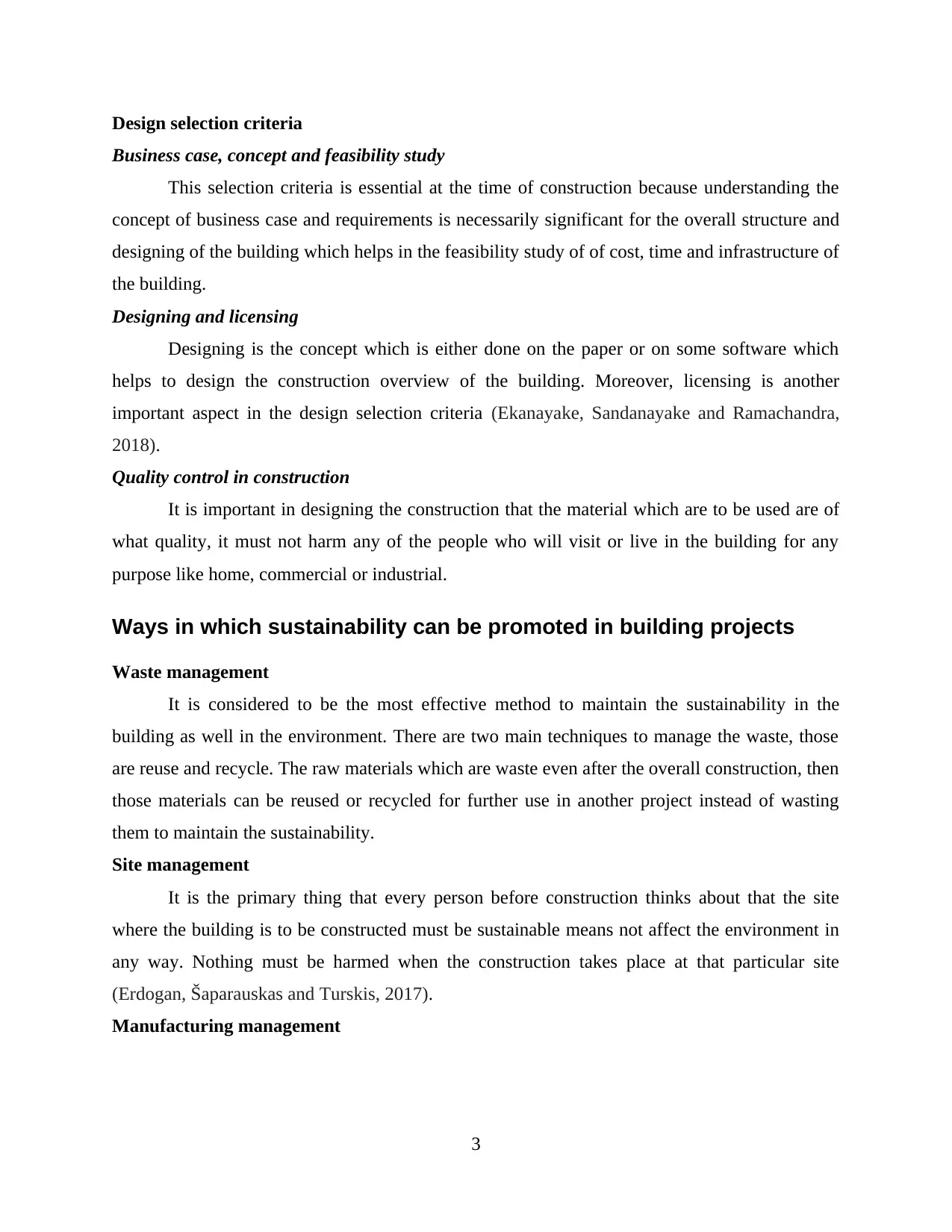
Design selection criteria
Business case, concept and feasibility study
This selection criteria is essential at the time of construction because understanding the
concept of business case and requirements is necessarily significant for the overall structure and
designing of the building which helps in the feasibility study of of cost, time and infrastructure of
the building.
Designing and licensing
Designing is the concept which is either done on the paper or on some software which
helps to design the construction overview of the building. Moreover, licensing is another
important aspect in the design selection criteria (Ekanayake, Sandanayake and Ramachandra,
2018).
Quality control in construction
It is important in designing the construction that the material which are to be used are of
what quality, it must not harm any of the people who will visit or live in the building for any
purpose like home, commercial or industrial.
Ways in which sustainability can be promoted in building projects
Waste management
It is considered to be the most effective method to maintain the sustainability in the
building as well in the environment. There are two main techniques to manage the waste, those
are reuse and recycle. The raw materials which are waste even after the overall construction, then
those materials can be reused or recycled for further use in another project instead of wasting
them to maintain the sustainability.
Site management
It is the primary thing that every person before construction thinks about that the site
where the building is to be constructed must be sustainable means not affect the environment in
any way. Nothing must be harmed when the construction takes place at that particular site
(Erdogan, Šaparauskas and Turskis, 2017).
Manufacturing management
3
Business case, concept and feasibility study
This selection criteria is essential at the time of construction because understanding the
concept of business case and requirements is necessarily significant for the overall structure and
designing of the building which helps in the feasibility study of of cost, time and infrastructure of
the building.
Designing and licensing
Designing is the concept which is either done on the paper or on some software which
helps to design the construction overview of the building. Moreover, licensing is another
important aspect in the design selection criteria (Ekanayake, Sandanayake and Ramachandra,
2018).
Quality control in construction
It is important in designing the construction that the material which are to be used are of
what quality, it must not harm any of the people who will visit or live in the building for any
purpose like home, commercial or industrial.
Ways in which sustainability can be promoted in building projects
Waste management
It is considered to be the most effective method to maintain the sustainability in the
building as well in the environment. There are two main techniques to manage the waste, those
are reuse and recycle. The raw materials which are waste even after the overall construction, then
those materials can be reused or recycled for further use in another project instead of wasting
them to maintain the sustainability.
Site management
It is the primary thing that every person before construction thinks about that the site
where the building is to be constructed must be sustainable means not affect the environment in
any way. Nothing must be harmed when the construction takes place at that particular site
(Erdogan, Šaparauskas and Turskis, 2017).
Manufacturing management
3
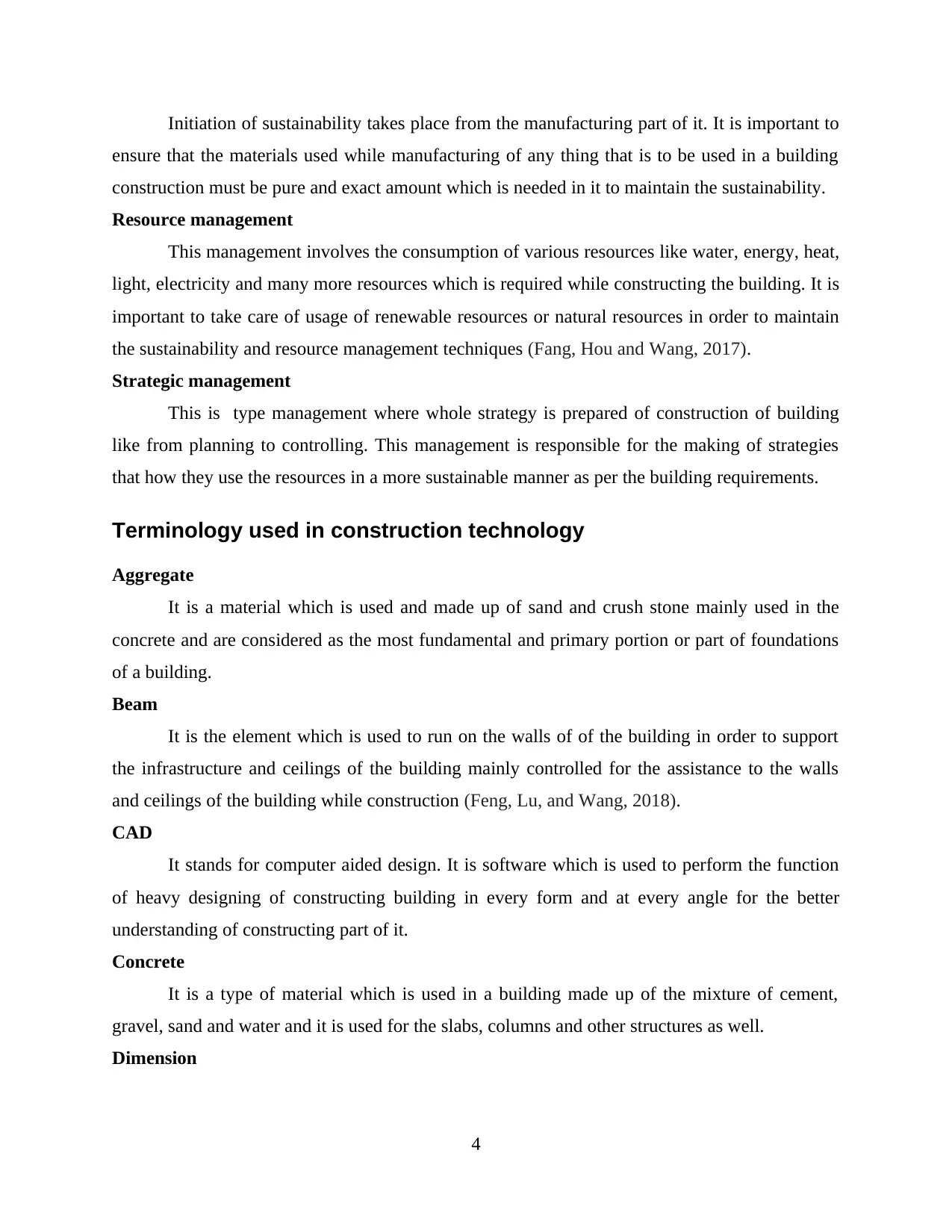
Initiation of sustainability takes place from the manufacturing part of it. It is important to
ensure that the materials used while manufacturing of any thing that is to be used in a building
construction must be pure and exact amount which is needed in it to maintain the sustainability.
Resource management
This management involves the consumption of various resources like water, energy, heat,
light, electricity and many more resources which is required while constructing the building. It is
important to take care of usage of renewable resources or natural resources in order to maintain
the sustainability and resource management techniques (Fang, Hou and Wang, 2017).
Strategic management
This is type management where whole strategy is prepared of construction of building
like from planning to controlling. This management is responsible for the making of strategies
that how they use the resources in a more sustainable manner as per the building requirements.
Terminology used in construction technology
Aggregate
It is a material which is used and made up of sand and crush stone mainly used in the
concrete and are considered as the most fundamental and primary portion or part of foundations
of a building.
Beam
It is the element which is used to run on the walls of of the building in order to support
the infrastructure and ceilings of the building mainly controlled for the assistance to the walls
and ceilings of the building while construction (Feng, Lu, and Wang, 2018).
CAD
It stands for computer aided design. It is software which is used to perform the function
of heavy designing of constructing building in every form and at every angle for the better
understanding of constructing part of it.
Concrete
It is a type of material which is used in a building made up of the mixture of cement,
gravel, sand and water and it is used for the slabs, columns and other structures as well.
Dimension
4
ensure that the materials used while manufacturing of any thing that is to be used in a building
construction must be pure and exact amount which is needed in it to maintain the sustainability.
Resource management
This management involves the consumption of various resources like water, energy, heat,
light, electricity and many more resources which is required while constructing the building. It is
important to take care of usage of renewable resources or natural resources in order to maintain
the sustainability and resource management techniques (Fang, Hou and Wang, 2017).
Strategic management
This is type management where whole strategy is prepared of construction of building
like from planning to controlling. This management is responsible for the making of strategies
that how they use the resources in a more sustainable manner as per the building requirements.
Terminology used in construction technology
Aggregate
It is a material which is used and made up of sand and crush stone mainly used in the
concrete and are considered as the most fundamental and primary portion or part of foundations
of a building.
Beam
It is the element which is used to run on the walls of of the building in order to support
the infrastructure and ceilings of the building mainly controlled for the assistance to the walls
and ceilings of the building while construction (Feng, Lu, and Wang, 2018).
CAD
It stands for computer aided design. It is software which is used to perform the function
of heavy designing of constructing building in every form and at every angle for the better
understanding of constructing part of it.
Concrete
It is a type of material which is used in a building made up of the mixture of cement,
gravel, sand and water and it is used for the slabs, columns and other structures as well.
Dimension
4
Paraphrase This Document
Need a fresh take? Get an instant paraphrase of this document with our AI Paraphraser
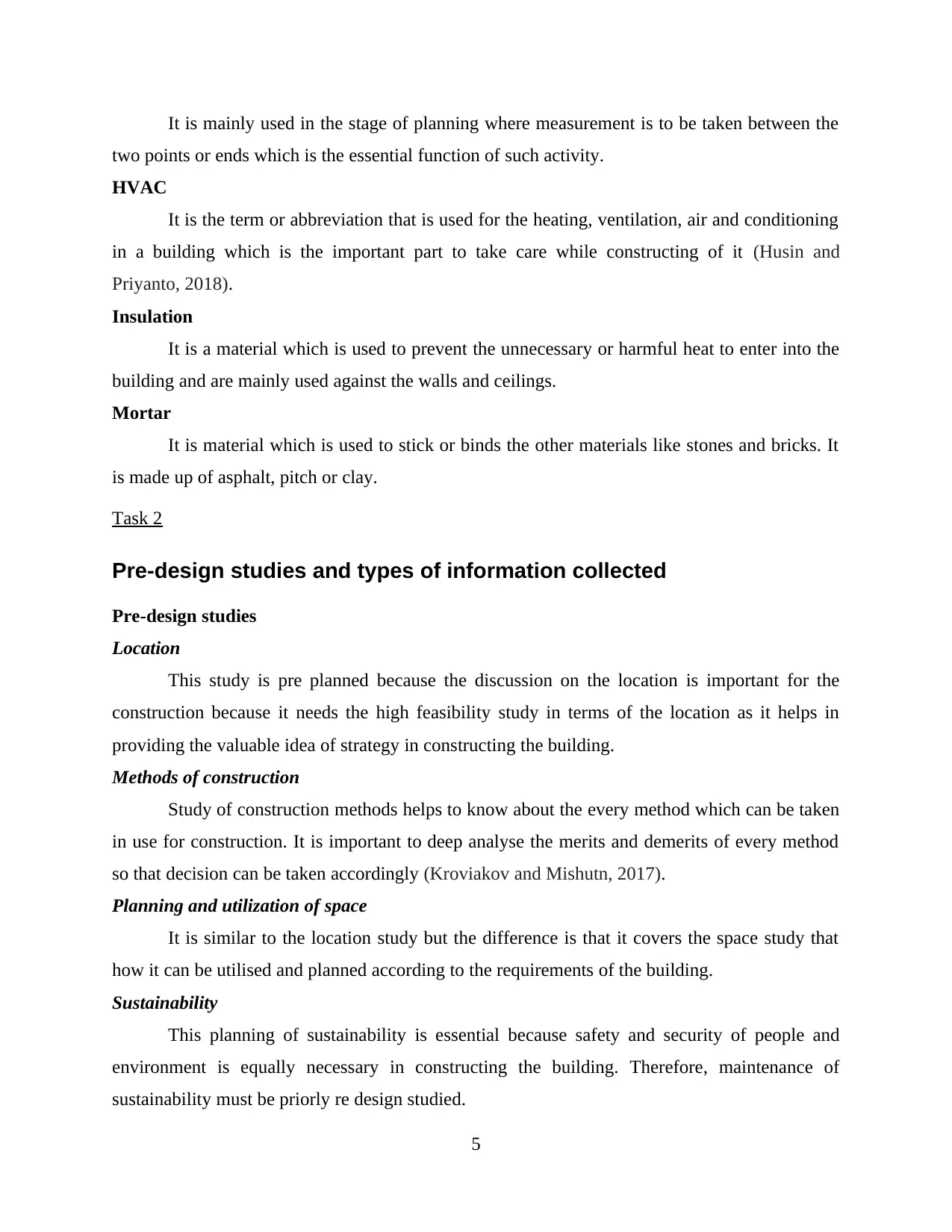
It is mainly used in the stage of planning where measurement is to be taken between the
two points or ends which is the essential function of such activity.
HVAC
It is the term or abbreviation that is used for the heating, ventilation, air and conditioning
in a building which is the important part to take care while constructing of it (Husin and
Priyanto, 2018).
Insulation
It is a material which is used to prevent the unnecessary or harmful heat to enter into the
building and are mainly used against the walls and ceilings.
Mortar
It is material which is used to stick or binds the other materials like stones and bricks. It
is made up of asphalt, pitch or clay.
Task 2
Pre-design studies and types of information collected
Pre-design studies
Location
This study is pre planned because the discussion on the location is important for the
construction because it needs the high feasibility study in terms of the location as it helps in
providing the valuable idea of strategy in constructing the building.
Methods of construction
Study of construction methods helps to know about the every method which can be taken
in use for construction. It is important to deep analyse the merits and demerits of every method
so that decision can be taken accordingly (Kroviakov and Mishutn, 2017).
Planning and utilization of space
It is similar to the location study but the difference is that it covers the space study that
how it can be utilised and planned according to the requirements of the building.
Sustainability
This planning of sustainability is essential because safety and security of people and
environment is equally necessary in constructing the building. Therefore, maintenance of
sustainability must be priorly re design studied.
5
two points or ends which is the essential function of such activity.
HVAC
It is the term or abbreviation that is used for the heating, ventilation, air and conditioning
in a building which is the important part to take care while constructing of it (Husin and
Priyanto, 2018).
Insulation
It is a material which is used to prevent the unnecessary or harmful heat to enter into the
building and are mainly used against the walls and ceilings.
Mortar
It is material which is used to stick or binds the other materials like stones and bricks. It
is made up of asphalt, pitch or clay.
Task 2
Pre-design studies and types of information collected
Pre-design studies
Location
This study is pre planned because the discussion on the location is important for the
construction because it needs the high feasibility study in terms of the location as it helps in
providing the valuable idea of strategy in constructing the building.
Methods of construction
Study of construction methods helps to know about the every method which can be taken
in use for construction. It is important to deep analyse the merits and demerits of every method
so that decision can be taken accordingly (Kroviakov and Mishutn, 2017).
Planning and utilization of space
It is similar to the location study but the difference is that it covers the space study that
how it can be utilised and planned according to the requirements of the building.
Sustainability
This planning of sustainability is essential because safety and security of people and
environment is equally necessary in constructing the building. Therefore, maintenance of
sustainability must be priorly re design studied.
5
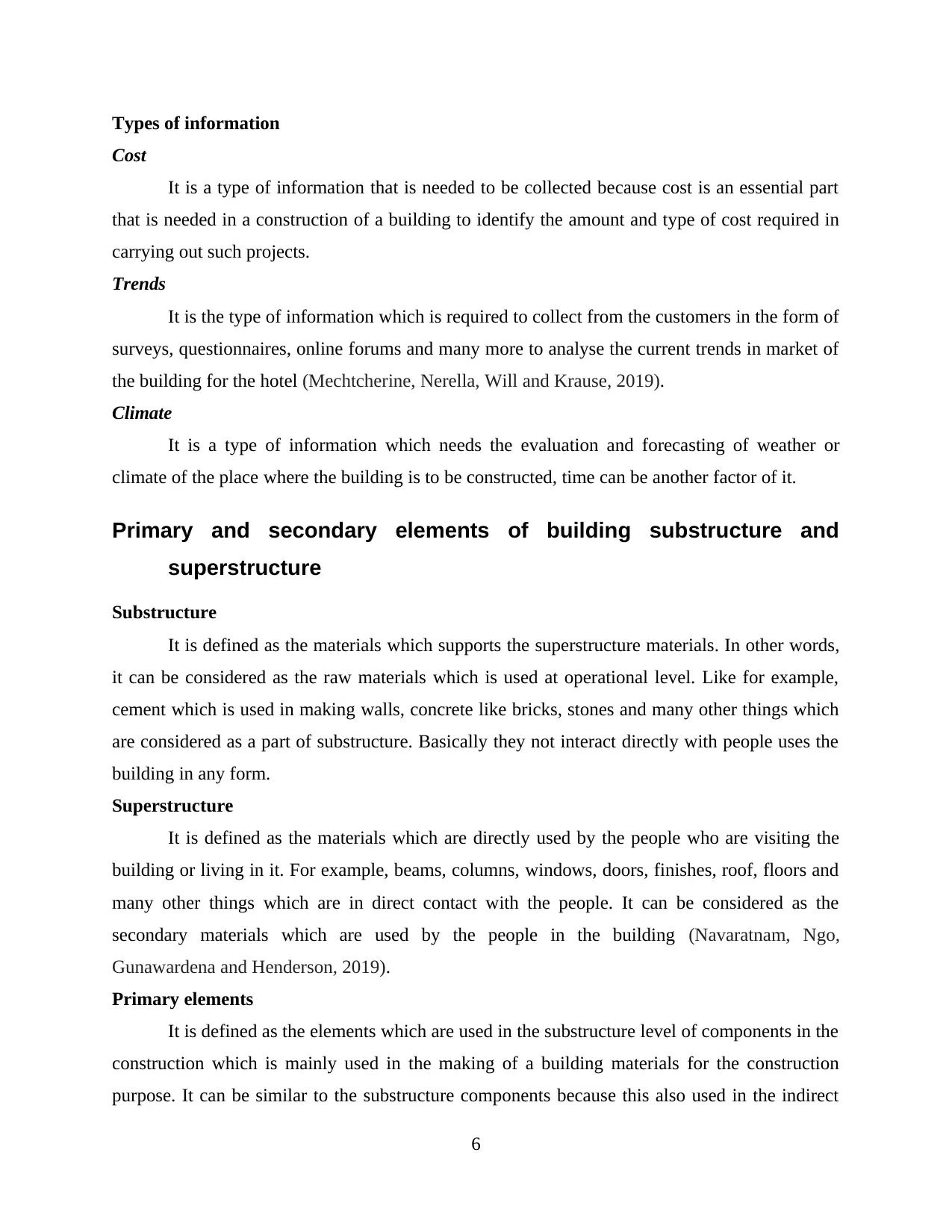
Types of information
Cost
It is a type of information that is needed to be collected because cost is an essential part
that is needed in a construction of a building to identify the amount and type of cost required in
carrying out such projects.
Trends
It is the type of information which is required to collect from the customers in the form of
surveys, questionnaires, online forums and many more to analyse the current trends in market of
the building for the hotel (Mechtcherine, Nerella, Will and Krause, 2019).
Climate
It is a type of information which needs the evaluation and forecasting of weather or
climate of the place where the building is to be constructed, time can be another factor of it.
Primary and secondary elements of building substructure and
superstructure
Substructure
It is defined as the materials which supports the superstructure materials. In other words,
it can be considered as the raw materials which is used at operational level. Like for example,
cement which is used in making walls, concrete like bricks, stones and many other things which
are considered as a part of substructure. Basically they not interact directly with people uses the
building in any form.
Superstructure
It is defined as the materials which are directly used by the people who are visiting the
building or living in it. For example, beams, columns, windows, doors, finishes, roof, floors and
many other things which are in direct contact with the people. It can be considered as the
secondary materials which are used by the people in the building (Navaratnam, Ngo,
Gunawardena and Henderson, 2019).
Primary elements
It is defined as the elements which are used in the substructure level of components in the
construction which is mainly used in the making of a building materials for the construction
purpose. It can be similar to the substructure components because this also used in the indirect
6
Cost
It is a type of information that is needed to be collected because cost is an essential part
that is needed in a construction of a building to identify the amount and type of cost required in
carrying out such projects.
Trends
It is the type of information which is required to collect from the customers in the form of
surveys, questionnaires, online forums and many more to analyse the current trends in market of
the building for the hotel (Mechtcherine, Nerella, Will and Krause, 2019).
Climate
It is a type of information which needs the evaluation and forecasting of weather or
climate of the place where the building is to be constructed, time can be another factor of it.
Primary and secondary elements of building substructure and
superstructure
Substructure
It is defined as the materials which supports the superstructure materials. In other words,
it can be considered as the raw materials which is used at operational level. Like for example,
cement which is used in making walls, concrete like bricks, stones and many other things which
are considered as a part of substructure. Basically they not interact directly with people uses the
building in any form.
Superstructure
It is defined as the materials which are directly used by the people who are visiting the
building or living in it. For example, beams, columns, windows, doors, finishes, roof, floors and
many other things which are in direct contact with the people. It can be considered as the
secondary materials which are used by the people in the building (Navaratnam, Ngo,
Gunawardena and Henderson, 2019).
Primary elements
It is defined as the elements which are used in the substructure level of components in the
construction which is mainly used in the making of a building materials for the construction
purpose. It can be similar to the substructure components because this also used in the indirect
6
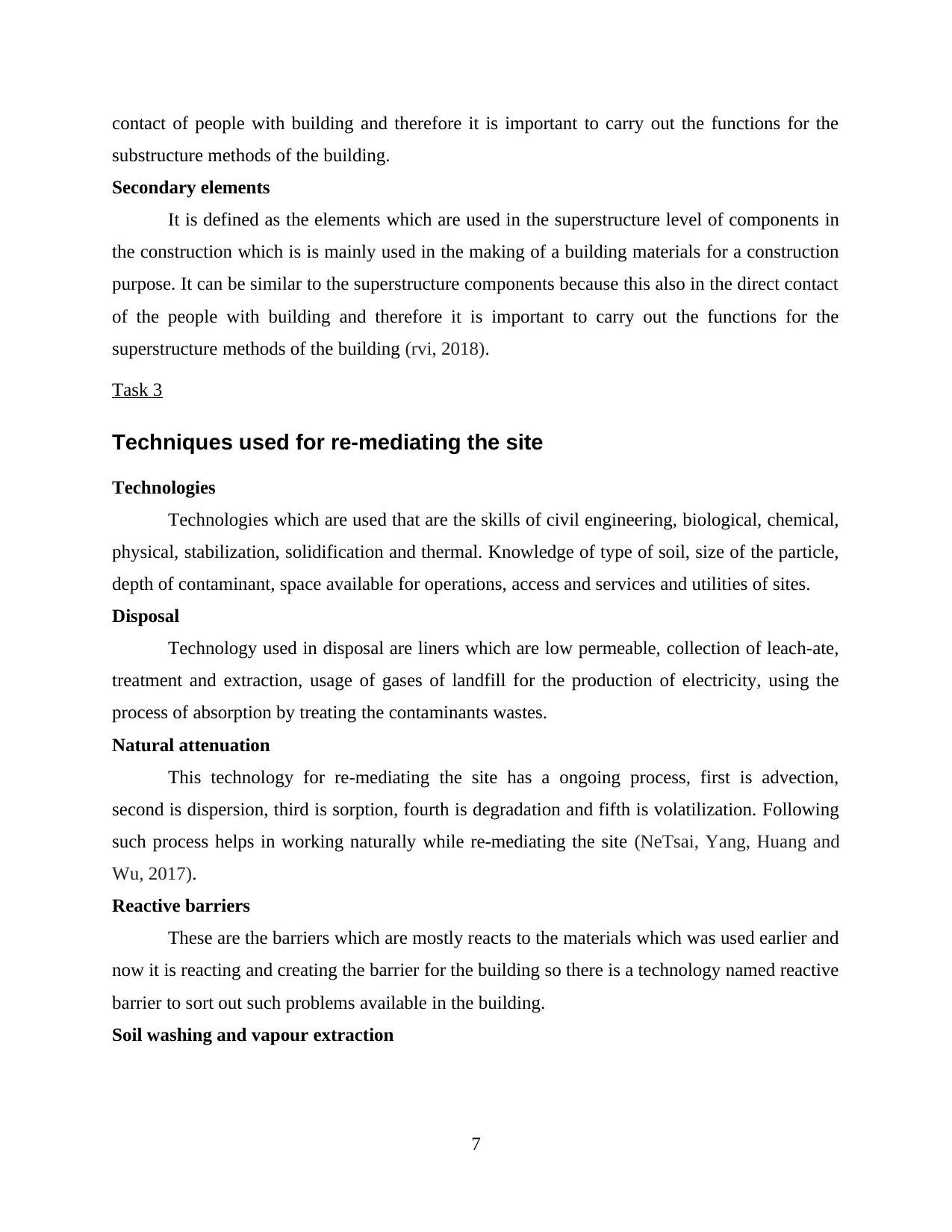
contact of people with building and therefore it is important to carry out the functions for the
substructure methods of the building.
Secondary elements
It is defined as the elements which are used in the superstructure level of components in
the construction which is is mainly used in the making of a building materials for a construction
purpose. It can be similar to the superstructure components because this also in the direct contact
of the people with building and therefore it is important to carry out the functions for the
superstructure methods of the building (rvi, 2018).
Task 3
Techniques used for re-mediating the site
Technologies
Technologies which are used that are the skills of civil engineering, biological, chemical,
physical, stabilization, solidification and thermal. Knowledge of type of soil, size of the particle,
depth of contaminant, space available for operations, access and services and utilities of sites.
Disposal
Technology used in disposal are liners which are low permeable, collection of leach-ate,
treatment and extraction, usage of gases of landfill for the production of electricity, using the
process of absorption by treating the contaminants wastes.
Natural attenuation
This technology for re-mediating the site has a ongoing process, first is advection,
second is dispersion, third is sorption, fourth is degradation and fifth is volatilization. Following
such process helps in working naturally while re-mediating the site (NeTsai, Yang, Huang and
Wu, 2017).
Reactive barriers
These are the barriers which are mostly reacts to the materials which was used earlier and
now it is reacting and creating the barrier for the building so there is a technology named reactive
barrier to sort out such problems available in the building.
Soil washing and vapour extraction
7
substructure methods of the building.
Secondary elements
It is defined as the elements which are used in the superstructure level of components in
the construction which is is mainly used in the making of a building materials for a construction
purpose. It can be similar to the superstructure components because this also in the direct contact
of the people with building and therefore it is important to carry out the functions for the
superstructure methods of the building (rvi, 2018).
Task 3
Techniques used for re-mediating the site
Technologies
Technologies which are used that are the skills of civil engineering, biological, chemical,
physical, stabilization, solidification and thermal. Knowledge of type of soil, size of the particle,
depth of contaminant, space available for operations, access and services and utilities of sites.
Disposal
Technology used in disposal are liners which are low permeable, collection of leach-ate,
treatment and extraction, usage of gases of landfill for the production of electricity, using the
process of absorption by treating the contaminants wastes.
Natural attenuation
This technology for re-mediating the site has a ongoing process, first is advection,
second is dispersion, third is sorption, fourth is degradation and fifth is volatilization. Following
such process helps in working naturally while re-mediating the site (NeTsai, Yang, Huang and
Wu, 2017).
Reactive barriers
These are the barriers which are mostly reacts to the materials which was used earlier and
now it is reacting and creating the barrier for the building so there is a technology named reactive
barrier to sort out such problems available in the building.
Soil washing and vapour extraction
7
Secure Best Marks with AI Grader
Need help grading? Try our AI Grader for instant feedback on your assignments.
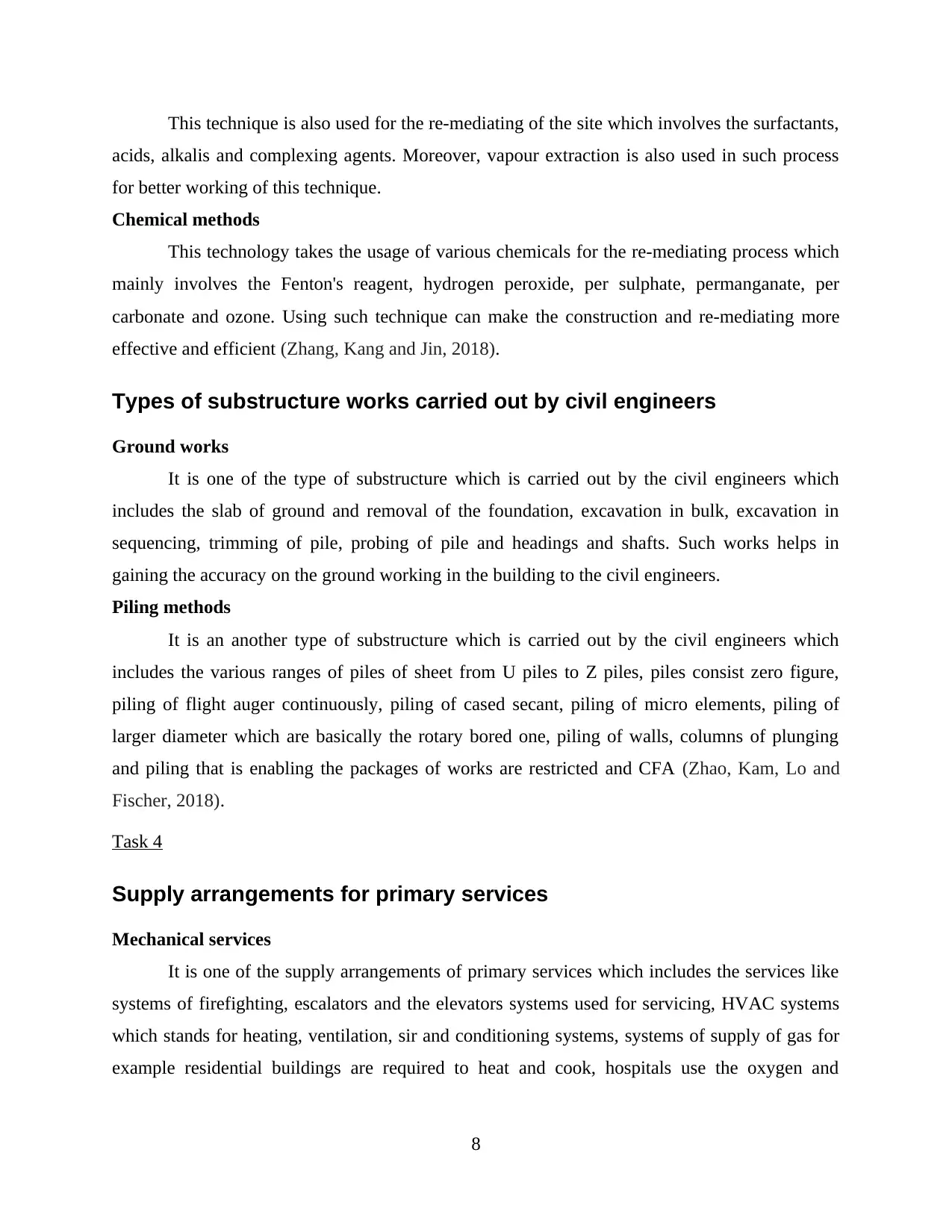
This technique is also used for the re-mediating of the site which involves the surfactants,
acids, alkalis and complexing agents. Moreover, vapour extraction is also used in such process
for better working of this technique.
Chemical methods
This technology takes the usage of various chemicals for the re-mediating process which
mainly involves the Fenton's reagent, hydrogen peroxide, per sulphate, permanganate, per
carbonate and ozone. Using such technique can make the construction and re-mediating more
effective and efficient (Zhang, Kang and Jin, 2018).
Types of substructure works carried out by civil engineers
Ground works
It is one of the type of substructure which is carried out by the civil engineers which
includes the slab of ground and removal of the foundation, excavation in bulk, excavation in
sequencing, trimming of pile, probing of pile and headings and shafts. Such works helps in
gaining the accuracy on the ground working in the building to the civil engineers.
Piling methods
It is an another type of substructure which is carried out by the civil engineers which
includes the various ranges of piles of sheet from U piles to Z piles, piles consist zero figure,
piling of flight auger continuously, piling of cased secant, piling of micro elements, piling of
larger diameter which are basically the rotary bored one, piling of walls, columns of plunging
and piling that is enabling the packages of works are restricted and CFA (Zhao, Kam, Lo and
Fischer, 2018).
Task 4
Supply arrangements for primary services
Mechanical services
It is one of the supply arrangements of primary services which includes the services like
systems of firefighting, escalators and the elevators systems used for servicing, HVAC systems
which stands for heating, ventilation, sir and conditioning systems, systems of supply of gas for
example residential buildings are required to heat and cook, hospitals use the oxygen and
8
acids, alkalis and complexing agents. Moreover, vapour extraction is also used in such process
for better working of this technique.
Chemical methods
This technology takes the usage of various chemicals for the re-mediating process which
mainly involves the Fenton's reagent, hydrogen peroxide, per sulphate, permanganate, per
carbonate and ozone. Using such technique can make the construction and re-mediating more
effective and efficient (Zhang, Kang and Jin, 2018).
Types of substructure works carried out by civil engineers
Ground works
It is one of the type of substructure which is carried out by the civil engineers which
includes the slab of ground and removal of the foundation, excavation in bulk, excavation in
sequencing, trimming of pile, probing of pile and headings and shafts. Such works helps in
gaining the accuracy on the ground working in the building to the civil engineers.
Piling methods
It is an another type of substructure which is carried out by the civil engineers which
includes the various ranges of piles of sheet from U piles to Z piles, piles consist zero figure,
piling of flight auger continuously, piling of cased secant, piling of micro elements, piling of
larger diameter which are basically the rotary bored one, piling of walls, columns of plunging
and piling that is enabling the packages of works are restricted and CFA (Zhao, Kam, Lo and
Fischer, 2018).
Task 4
Supply arrangements for primary services
Mechanical services
It is one of the supply arrangements of primary services which includes the services like
systems of firefighting, escalators and the elevators systems used for servicing, HVAC systems
which stands for heating, ventilation, sir and conditioning systems, systems of supply of gas for
example residential buildings are required to heat and cook, hospitals use the oxygen and
8
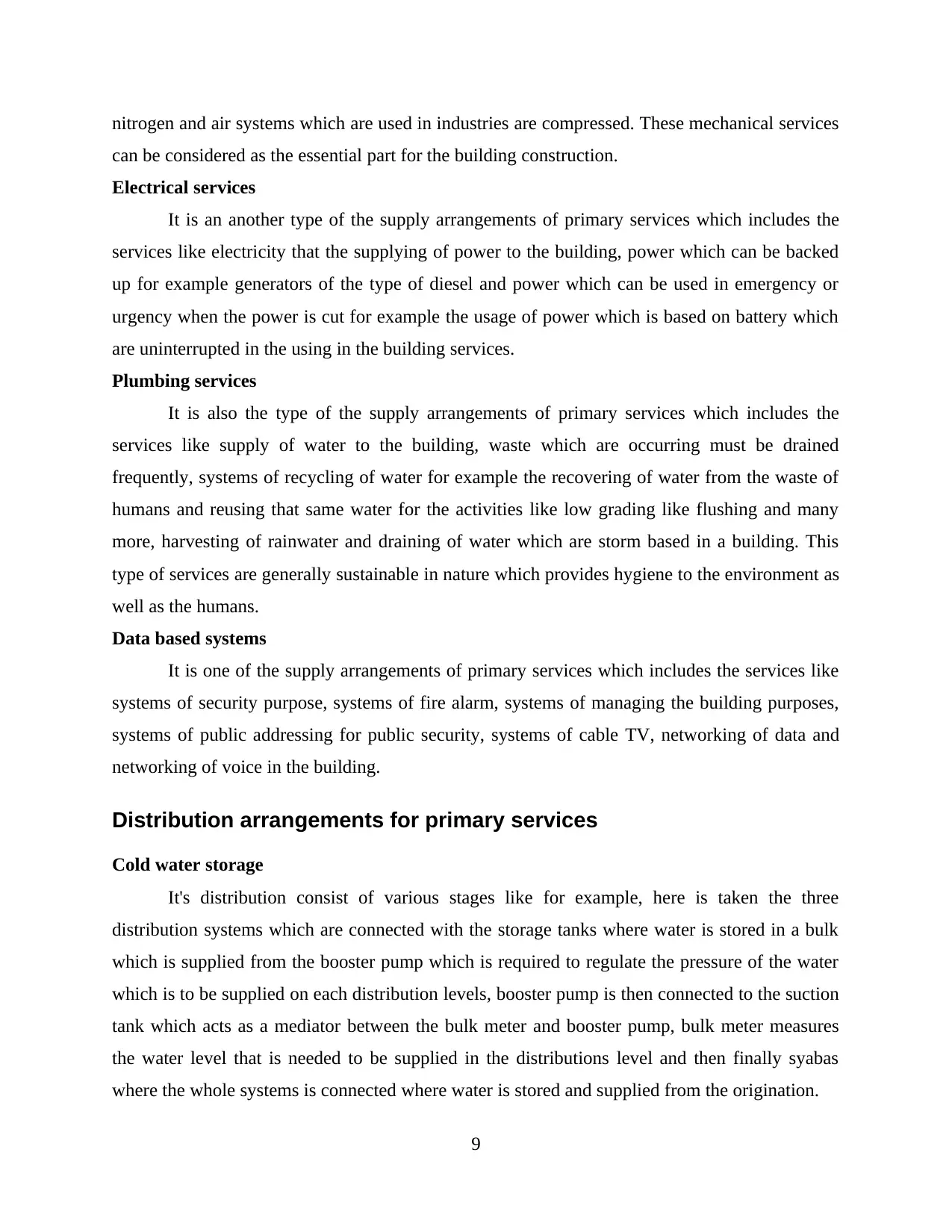
nitrogen and air systems which are used in industries are compressed. These mechanical services
can be considered as the essential part for the building construction.
Electrical services
It is an another type of the supply arrangements of primary services which includes the
services like electricity that the supplying of power to the building, power which can be backed
up for example generators of the type of diesel and power which can be used in emergency or
urgency when the power is cut for example the usage of power which is based on battery which
are uninterrupted in the using in the building services.
Plumbing services
It is also the type of the supply arrangements of primary services which includes the
services like supply of water to the building, waste which are occurring must be drained
frequently, systems of recycling of water for example the recovering of water from the waste of
humans and reusing that same water for the activities like low grading like flushing and many
more, harvesting of rainwater and draining of water which are storm based in a building. This
type of services are generally sustainable in nature which provides hygiene to the environment as
well as the humans.
Data based systems
It is one of the supply arrangements of primary services which includes the services like
systems of security purpose, systems of fire alarm, systems of managing the building purposes,
systems of public addressing for public security, systems of cable TV, networking of data and
networking of voice in the building.
Distribution arrangements for primary services
Cold water storage
It's distribution consist of various stages like for example, here is taken the three
distribution systems which are connected with the storage tanks where water is stored in a bulk
which is supplied from the booster pump which is required to regulate the pressure of the water
which is to be supplied on each distribution levels, booster pump is then connected to the suction
tank which acts as a mediator between the bulk meter and booster pump, bulk meter measures
the water level that is needed to be supplied in the distributions level and then finally syabas
where the whole systems is connected where water is stored and supplied from the origination.
9
can be considered as the essential part for the building construction.
Electrical services
It is an another type of the supply arrangements of primary services which includes the
services like electricity that the supplying of power to the building, power which can be backed
up for example generators of the type of diesel and power which can be used in emergency or
urgency when the power is cut for example the usage of power which is based on battery which
are uninterrupted in the using in the building services.
Plumbing services
It is also the type of the supply arrangements of primary services which includes the
services like supply of water to the building, waste which are occurring must be drained
frequently, systems of recycling of water for example the recovering of water from the waste of
humans and reusing that same water for the activities like low grading like flushing and many
more, harvesting of rainwater and draining of water which are storm based in a building. This
type of services are generally sustainable in nature which provides hygiene to the environment as
well as the humans.
Data based systems
It is one of the supply arrangements of primary services which includes the services like
systems of security purpose, systems of fire alarm, systems of managing the building purposes,
systems of public addressing for public security, systems of cable TV, networking of data and
networking of voice in the building.
Distribution arrangements for primary services
Cold water storage
It's distribution consist of various stages like for example, here is taken the three
distribution systems which are connected with the storage tanks where water is stored in a bulk
which is supplied from the booster pump which is required to regulate the pressure of the water
which is to be supplied on each distribution levels, booster pump is then connected to the suction
tank which acts as a mediator between the bulk meter and booster pump, bulk meter measures
the water level that is needed to be supplied in the distributions level and then finally syabas
where the whole systems is connected where water is stored and supplied from the origination.
9
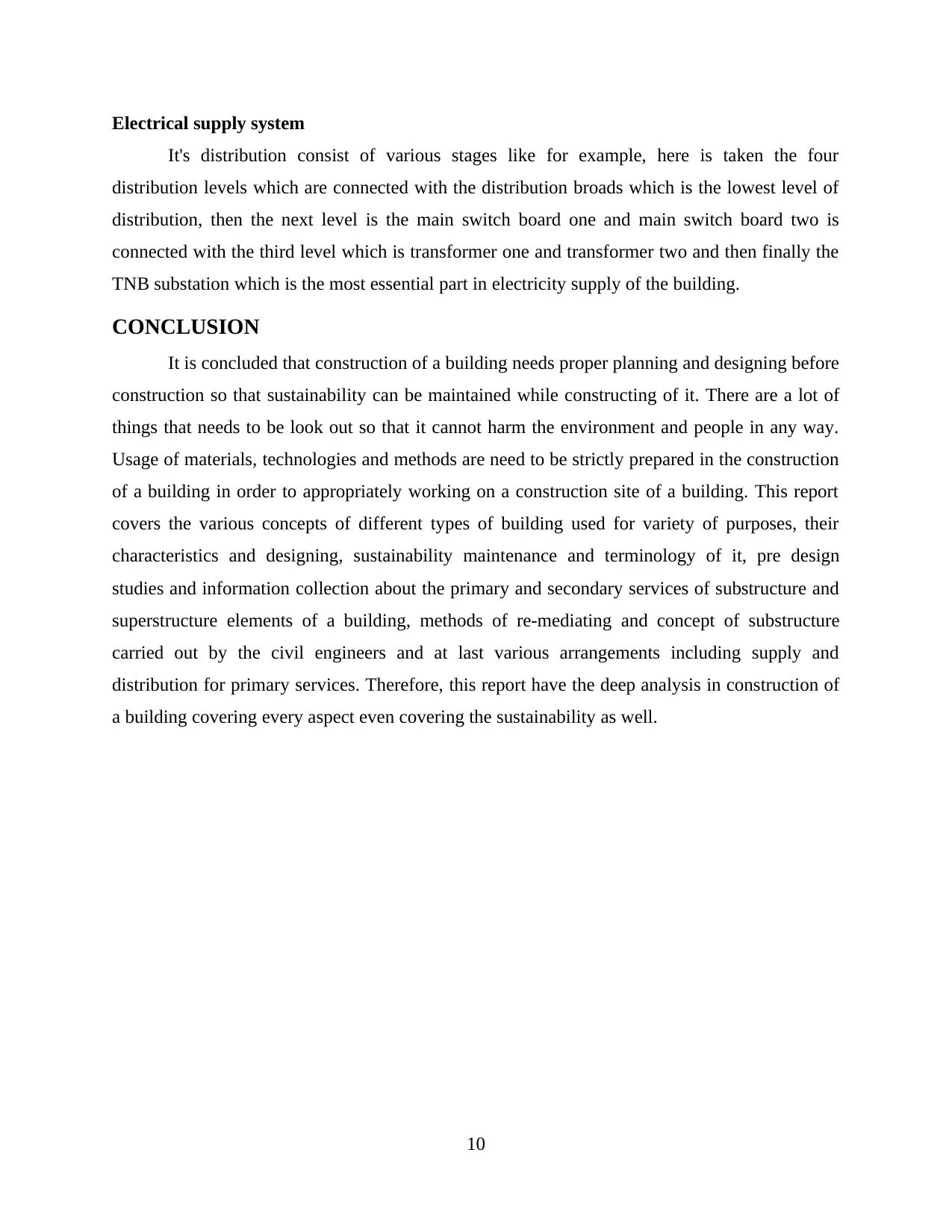
Electrical supply system
It's distribution consist of various stages like for example, here is taken the four
distribution levels which are connected with the distribution broads which is the lowest level of
distribution, then the next level is the main switch board one and main switch board two is
connected with the third level which is transformer one and transformer two and then finally the
TNB substation which is the most essential part in electricity supply of the building.
CONCLUSION
It is concluded that construction of a building needs proper planning and designing before
construction so that sustainability can be maintained while constructing of it. There are a lot of
things that needs to be look out so that it cannot harm the environment and people in any way.
Usage of materials, technologies and methods are need to be strictly prepared in the construction
of a building in order to appropriately working on a construction site of a building. This report
covers the various concepts of different types of building used for variety of purposes, their
characteristics and designing, sustainability maintenance and terminology of it, pre design
studies and information collection about the primary and secondary services of substructure and
superstructure elements of a building, methods of re-mediating and concept of substructure
carried out by the civil engineers and at last various arrangements including supply and
distribution for primary services. Therefore, this report have the deep analysis in construction of
a building covering every aspect even covering the sustainability as well.
10
It's distribution consist of various stages like for example, here is taken the four
distribution levels which are connected with the distribution broads which is the lowest level of
distribution, then the next level is the main switch board one and main switch board two is
connected with the third level which is transformer one and transformer two and then finally the
TNB substation which is the most essential part in electricity supply of the building.
CONCLUSION
It is concluded that construction of a building needs proper planning and designing before
construction so that sustainability can be maintained while constructing of it. There are a lot of
things that needs to be look out so that it cannot harm the environment and people in any way.
Usage of materials, technologies and methods are need to be strictly prepared in the construction
of a building in order to appropriately working on a construction site of a building. This report
covers the various concepts of different types of building used for variety of purposes, their
characteristics and designing, sustainability maintenance and terminology of it, pre design
studies and information collection about the primary and secondary services of substructure and
superstructure elements of a building, methods of re-mediating and concept of substructure
carried out by the civil engineers and at last various arrangements including supply and
distribution for primary services. Therefore, this report have the deep analysis in construction of
a building covering every aspect even covering the sustainability as well.
10
Paraphrase This Document
Need a fresh take? Get an instant paraphrase of this document with our AI Paraphraser
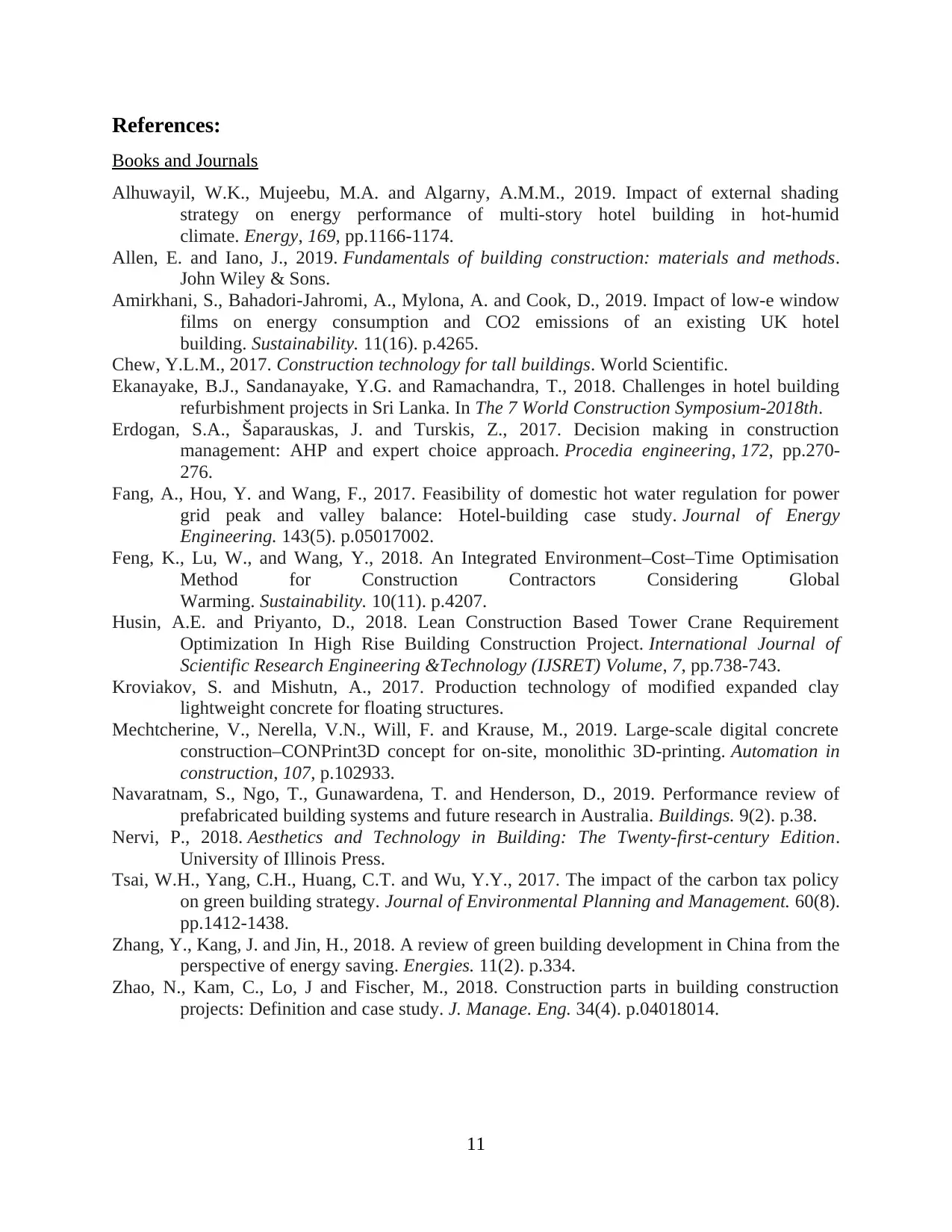
References:
Books and Journals
Alhuwayil, W.K., Mujeebu, M.A. and Algarny, A.M.M., 2019. Impact of external shading
strategy on energy performance of multi-story hotel building in hot-humid
climate. Energy, 169, pp.1166-1174.
Allen, E. and Iano, J., 2019. Fundamentals of building construction: materials and methods.
John Wiley & Sons.
Amirkhani, S., Bahadori-Jahromi, A., Mylona, A. and Cook, D., 2019. Impact of low-e window
films on energy consumption and CO2 emissions of an existing UK hotel
building. Sustainability. 11(16). p.4265.
Chew, Y.L.M., 2017. Construction technology for tall buildings. World Scientific.
Ekanayake, B.J., Sandanayake, Y.G. and Ramachandra, T., 2018. Challenges in hotel building
refurbishment projects in Sri Lanka. In The 7 World Construction Symposium-2018th.
Erdogan, S.A., Šaparauskas, J. and Turskis, Z., 2017. Decision making in construction
management: AHP and expert choice approach. Procedia engineering, 172, pp.270-
276.
Fang, A., Hou, Y. and Wang, F., 2017. Feasibility of domestic hot water regulation for power
grid peak and valley balance: Hotel-building case study. Journal of Energy
Engineering. 143(5). p.05017002.
Feng, K., Lu, W., and Wang, Y., 2018. An Integrated Environment–Cost–Time Optimisation
Method for Construction Contractors Considering Global
Warming. Sustainability. 10(11). p.4207.
Husin, A.E. and Priyanto, D., 2018. Lean Construction Based Tower Crane Requirement
Optimization In High Rise Building Construction Project. International Journal of
Scientific Research Engineering &Technology (IJSRET) Volume, 7, pp.738-743.
Kroviakov, S. and Mishutn, A., 2017. Production technology of modified expanded clay
lightweight concrete for floating structures.
Mechtcherine, V., Nerella, V.N., Will, F. and Krause, M., 2019. Large-scale digital concrete
construction–CONPrint3D concept for on-site, monolithic 3D-printing. Automation in
construction, 107, p.102933.
Navaratnam, S., Ngo, T., Gunawardena, T. and Henderson, D., 2019. Performance review of
prefabricated building systems and future research in Australia. Buildings. 9(2). p.38.
Nervi, P., 2018. Aesthetics and Technology in Building: The Twenty-first-century Edition.
University of Illinois Press.
Tsai, W.H., Yang, C.H., Huang, C.T. and Wu, Y.Y., 2017. The impact of the carbon tax policy
on green building strategy. Journal of Environmental Planning and Management. 60(8).
pp.1412-1438.
Zhang, Y., Kang, J. and Jin, H., 2018. A review of green building development in China from the
perspective of energy saving. Energies. 11(2). p.334.
Zhao, N., Kam, C., Lo, J and Fischer, M., 2018. Construction parts in building construction
projects: Definition and case study. J. Manage. Eng. 34(4). p.04018014.
11
Books and Journals
Alhuwayil, W.K., Mujeebu, M.A. and Algarny, A.M.M., 2019. Impact of external shading
strategy on energy performance of multi-story hotel building in hot-humid
climate. Energy, 169, pp.1166-1174.
Allen, E. and Iano, J., 2019. Fundamentals of building construction: materials and methods.
John Wiley & Sons.
Amirkhani, S., Bahadori-Jahromi, A., Mylona, A. and Cook, D., 2019. Impact of low-e window
films on energy consumption and CO2 emissions of an existing UK hotel
building. Sustainability. 11(16). p.4265.
Chew, Y.L.M., 2017. Construction technology for tall buildings. World Scientific.
Ekanayake, B.J., Sandanayake, Y.G. and Ramachandra, T., 2018. Challenges in hotel building
refurbishment projects in Sri Lanka. In The 7 World Construction Symposium-2018th.
Erdogan, S.A., Šaparauskas, J. and Turskis, Z., 2017. Decision making in construction
management: AHP and expert choice approach. Procedia engineering, 172, pp.270-
276.
Fang, A., Hou, Y. and Wang, F., 2017. Feasibility of domestic hot water regulation for power
grid peak and valley balance: Hotel-building case study. Journal of Energy
Engineering. 143(5). p.05017002.
Feng, K., Lu, W., and Wang, Y., 2018. An Integrated Environment–Cost–Time Optimisation
Method for Construction Contractors Considering Global
Warming. Sustainability. 10(11). p.4207.
Husin, A.E. and Priyanto, D., 2018. Lean Construction Based Tower Crane Requirement
Optimization In High Rise Building Construction Project. International Journal of
Scientific Research Engineering &Technology (IJSRET) Volume, 7, pp.738-743.
Kroviakov, S. and Mishutn, A., 2017. Production technology of modified expanded clay
lightweight concrete for floating structures.
Mechtcherine, V., Nerella, V.N., Will, F. and Krause, M., 2019. Large-scale digital concrete
construction–CONPrint3D concept for on-site, monolithic 3D-printing. Automation in
construction, 107, p.102933.
Navaratnam, S., Ngo, T., Gunawardena, T. and Henderson, D., 2019. Performance review of
prefabricated building systems and future research in Australia. Buildings. 9(2). p.38.
Nervi, P., 2018. Aesthetics and Technology in Building: The Twenty-first-century Edition.
University of Illinois Press.
Tsai, W.H., Yang, C.H., Huang, C.T. and Wu, Y.Y., 2017. The impact of the carbon tax policy
on green building strategy. Journal of Environmental Planning and Management. 60(8).
pp.1412-1438.
Zhang, Y., Kang, J. and Jin, H., 2018. A review of green building development in China from the
perspective of energy saving. Energies. 11(2). p.334.
Zhao, N., Kam, C., Lo, J and Fischer, M., 2018. Construction parts in building construction
projects: Definition and case study. J. Manage. Eng. 34(4). p.04018014.
11
1 out of 14
Related Documents
Your All-in-One AI-Powered Toolkit for Academic Success.
+13062052269
info@desklib.com
Available 24*7 on WhatsApp / Email
![[object Object]](/_next/static/media/star-bottom.7253800d.svg)
Unlock your academic potential
© 2024 | Zucol Services PVT LTD | All rights reserved.





